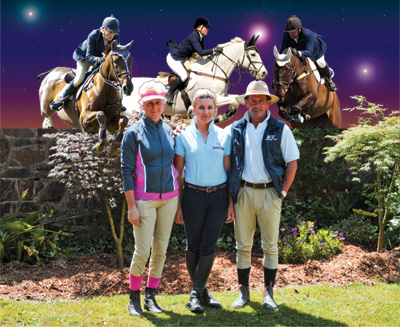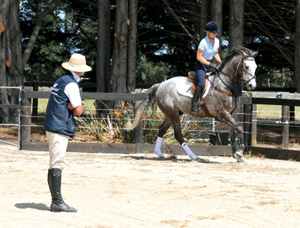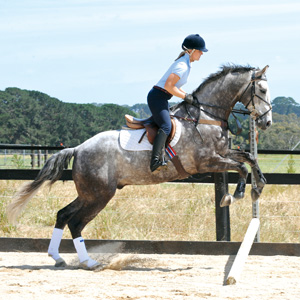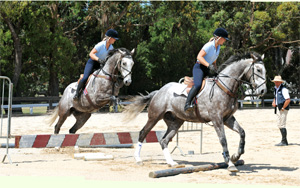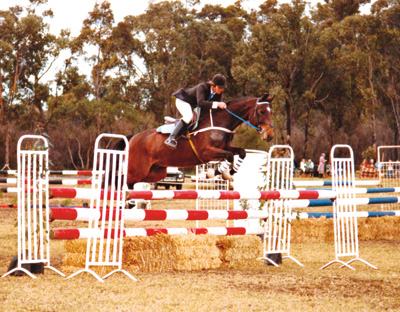You can tell in those crucial first couple of steps when horses – particularly young horses – have been ridden correctly… they go easily and without fuss into a nice frame. I guess, given Jamie Coman’s reputation for demanding first class work on the flat, it should come as no surprise that the minute his wife, Sue, and her four year old Nic of Time (by Nicklaus) and daughter, Hayley’s four year old Coolart Farm Hopscotch (by Hamlet) hit the dressage arena, that both the babies were sweetly operating.
“Hayley, bend him a little to the outside, now a little to the inside, Sue, make sure the reins are even, don’t get to working on one rein…”
Jamie knows that good riding and excellent training comes from attention to the details.
The riders are working the long side of the arena and Jamie has three poles sitting in cups attached to the fence and on the ground in the arena, it’s an exercise to get both horse and rider looking, reading the distances, but the introduction of a jumping element must not spoil the quality of the work…
“Circle at the end, make him listen to your inside leg, make him soft. Hayley, with your horse, I want you to slow him down and keep the bend as you go down the line.”
And when Jamie still isn’t happy, Hayley is to pop over the first, make a fifteen metre circle, pop the second, make another little circle, and over the last rail. “Now soften, and let him stretch more… Be careful, you are trying to force him into a beautiful shape, you must let him go and let him find that beautiful shape. Remember he is only four years old, let him learn to carry you in a light seat. Try it on the right rein…”
So Hayley tries it on the right rein, and finds three awful spots.
“Don’t anticipate, let him focus and find a distance. Don’t you try to tell him too much.”
Talking later, Jamie emphasised, letting the young horse learn its own lessons:
“They have got to find their balance in carrying the rider, getting stronger and growing up, learning to focus from one fence to the other. I put the poles down the long side to help them learn, give them something else to do.
Ask them to bend around the inside leg, but give them a little pole as well so they have got to keep their attention on what they are doing – so they don’t get bored with their work. And it is good for the rider, you can teach them to close the canter up so much more by that exercise, than just trying to force them on the flat.”
You were very insistent on keeping that bend around the inside leg…
“I always want them to work from behind through, and be soft, so they learn to travel through their turns very balanced and very nice.”
The next exercise was more of the same: A pole on the ground, nine yards to a little vertical, then nine or ten yards to another pole.
“Again this is just encouraging them to find and learn that they can have two strides from that pole to the fence. We make the rider accurate by jumping the pole and then just allowing the two strides to happen. I want them to land and think about the pole on the other side, and carry two strides to that pole. In doing that you can work on the rider as well, their lower leg, check their eye is up, and they have a soft release at the base of the fence.”
Once again, it is an exercise for horse and rider, and this time Jamie is emphasising the need for a nice connection: “Sue, keep that nice connection all the way. I’ve closed the distance up a bit, so try to let him get a little more to the base. Don’t throw your body too much, be careful not to twist your body on landing, land with an even pressure on both stirrups.”
The next exercise was once again working on bend and softness. A circle with a pole in front of a tiny vertical. “This little fan, with a pole on either side of the jump: two metres on the inside, and four metres on the outside, jumping the pole in the centre on the circle. Make them come around the leg, try and get the horse soft. In doing that exercise we also had the horse thinking about the little jump, teaching them technique in front. So they learn later in jump-offs, they can be turning in the air, and still hold the technique in their jump.”
It was Hayley’s turn to try the exercise. ‘What do you think is going to happen?’ Jamie asks his daughter. “It could be interesting…” “Just let him find his way, let him learn to carry you softly. Don’t anticipate what is going to happen, wait for him, stay with your horse as a combination.”
And of course, the exercise comes up beautifully, but Jamie has a point to make: “When you start to anticipate, then you get in front of the horse. It’s the same with the flying changes, don’t anticipate, wait until you can feel the job is done. This exercise is good for your eye, and for getting a nice, soft jump.”
It was time to move on to the final exercise: a pole, nine feet to a little plank, nine feet to another little plank, ten feet to a little oxer, then three strides to a narrow fence.
“It’s just a little bounce. A canter pole to it again – always use a canter pole because then we know we are going to get our young horses there safe. The rider has to focus and make sure they get it right at the pole. Then nine feet to the little plank, nine feet again to another plank, then ten feet with a little more room, to a little oxer. Having an oxer in a bounce is quite tough work, so I kept it very small. Although they had to focus ahead, the three strides to the little narrow fence, they still have know where their legs are. They have to be thinking, ‘direction straight ahead’ but knowing that they have to get their legs out of the road, and use their technique.”
You were using side poles in the jump, and at the end of the jump?
“Yes, because I never want my rider to really take their mouth and take away any jump the horse is producing. I want to encourage horses always to make a good shape themselves. You don’t want to be guiding them too much. They need to learn the direction from the leg, not too much hand. The hand is always good as a soft hand, but not so much as a guiding hand.”
“Sue try popping him through these little bounces, then three strides to the skinny, and at the end of the line, work the circle again and get him listening to you… we don’t want him to focus on the stables. Let him make a little mistake, let him learn to focus on the top rail.”
“How was that?”
“It was awful.”
“Take an even contact on the reins and hold him a little straighter in the line. Better, but do it again, it still looks a bit hurried. It looks like you have to do too much with your hand.”
“He’s all over the place.”
“He’s a baby. That’s why I’ve got the skinny at the end, they learn to get their attention on a skinny fence. He’s got to learn you can close him with the leg and hand and then get soft, close and he doesn’t get quicker but he is just a baby.”
And it was enough work for one day for babies.
With young horses like these two, how many times a week would they work like this?
“Normally they would do at least 20/25 minutes working on the flat, a lot of walking and getting them soft and bending and learning how to go in a shape, and then at the end of a session, two times a week, they would do little gymnastics, like that, the gymnastic work just finishing off the work on the flat. Maybe going through the exercise six times and that is enough because you don’t want them to wear out as young horses.”
When do you start to take your young horses to a competition?
“These two have just started. We took them to the Australian Championships for the small classes, they did the 90 cm and metre five classes, and they coped very well. They will only do four or five shows maximum, and then they will have a rest, and then we start again. The way we spell them is, they are shod for five weeks, then we pull their shoes off for five weeks to rest them. We just work on a shoeing basis, five weeks on, five weeks off, then they don’t get sour, they enjoy their work…”
And it is not just the horses that have enjoyed the session. Hayley is jokes as we leave the arena, “It is great having you come down to do an article, that way I get a lesson, it’s the first lesson I’ve had in a month, you should come more often.”
And we did, and next month sit in as Jamie, Sue and Hayley move up the training and jumping scale…
Jamie Coman – Horses are my life…
“I’ve been riding for years. I grew up on a dairy farm on the NSW South Coast, and grew up riding with my father. When I was two I’d be on a pony tied to my father’s pony. I’ve been involved with horses all my life – Horse are my life.”
“I went through Pony Club, just another rider, maybe I used to win the Sporting events. Pony Club is a great learning base, you learn how to win, you learn how to be competitive, but it is all fun. Pony Club was just part of growing up then, that was what you did. It’s a good grounding, and a lot of people can afford Pony Club. The average family can go to Pony Club, and they can have a normal horse. I just rode Stock horses, then the Thoroughbreds started coming from the track. Normal horses and you made the most of what you had. I learnt my trade as a cabinet maker, but always my ambition was to ride.”
“For me it was always showjumping. Just watching the videos of Wentworth Park, and the shows in Western Australia in the days of the Bond Series… thinking, I’d love to do that. It looked great. Where I came from it was very hard to go and see those better riders. We were in the middle of the Bega Valley and to go either way was always a journey.”
“I’d made up my mind that I wanted to showjump properly so I just kept trying. I didn’t have anyone to teach me. I just watched, there were instructors at Pony club, but no proper coach until met Rod Brown. I found I could just work with him. I would have been 24 when I met him. I’d just started doing shows like Wentworth Park. I’d done that once and really enjoyed it, loved the big scene.”
“When Sue and I moved to Camden, we started to train with Rod.”
What was the first good horse?
“I had a really good horse that we bought from the sale yard, The Smuggler. He was a station bred horse – Thoroughbred over a Station mare. He was not a fast enough walker for the station, so he went to the Sales. I think we paid $175 for him. He competed Grand Prix. He placed at Wentworth Park in my first year. There used to be a show before Wentworth Park, the Andronicus Coffee show, and I won a class there. To me, that was a big deal. I’d never been to Sydney and to win a class like that meant everything. He was a great horse, he went on to compete for a lady in New Zealand.”
Jamie riding The Smuggler
Somewhere along the way, you have met up with your wife, Sue?
“After I’d done Wentworth Park, I started to do the bigger shows, she was competing, we met as friends. Then – yeah – I don’t know how it happened. We were at the Australian Championships at Geelong one year. It was her birthday, so we went out for a drink and I guess I ended up the birthday present. We’d met as shows just as competitors and good friends, but that was it after those championships. I moved to Queensland where she lived, pretty well straight away. We lived there for a while but we decided we needed to be where the scene was, and the scene was Sydney.”
“We set up our own little stables in Camden and I was full-time into horses, trying to produce showjumpers. We had great success, we’ve had some wonderful horses – like Mr Midnight, Casual… Modra, he took me to the other side of the world. He was a tough horse to ride but he carted me around some of the biggest tracks I’ve ever jumped, or ever will jump. He was a great little horse. Then of course, the Zazu horse that took me to the Sydney Games.”
Tough setting out on your own?
“It was, we’d bought a property, and needed to pay for that – and getting a name. Then the market was pretty well the Japanese market. They wanted them at a particular standard and age, and you had to produce… you had to do a lot of shows to get the performances for these horses. But we had good success, produced a lot of horses, tried a lot of horses – and you get to know what is good and what doesn’t work. I’d just started teaching then, but riding was what I wanted to do.”
What do you think you learnt from Rod Brown?
“He has so much knowledge. He can tell you about a show in any country anywhere in the world, and he can explain it so well, that when you do get there, you feel like you have already been there. He was always wanting good quality jumping horses and good quality riding, and that’s what I wanted to do. If I was going showjumping, I wanted to do it as good as I possibly could, and have the best horses that I could possibly produce…”
But this was a time in Australian jumping history when there was a lot of wild cowboys riding, you picked a minority stream?
“Yeah, I watched Rod ride and thought that’s how we want to do it, we want to be classical in our riding. We were just being introduced to people like George Morris, and it was amazing to do his clinics. He wanted you to be very classical in your ride.’
Was a clinic with George a shock?
“Very much so, in that he was tough, and he told you – if you rode awful, or untidy, or scruffy, he told you. There was no being nice about it, you fix it. If you want to train with me, you have to do it this way. It was good to have someone like that who made you a little scared of them and made you try harder. You made yourself ride well.”
But you teach like George, you are always looking at the details…
“I am picky like that, there is always something else. Every time I see one of my riders ride, I imagine I am riding that horse, and I know myself how I want to finish everything off, I always want a good picture. It may be right that we’ve got that exercise over and done with, but the job is not finished.”
Is it tough teaching your wife and your daughter?
“No, it’s great. Hayley and I are very similar. We work together very well, Sue is great to work with, and very knowledgeable. I’ve been very protective of Hayley, with what young horses I’ve let her ride, but now she is working with the young ones. She runs our stables for us, and she’s got the confidence and the ability to do it, it has to be run as a business, and that means she has to take over riding a lot of the young horses. I just guide her along the way, and she is doing a good job with them…”
Next month, follow Jamie as he starts to compete internationally and train in Europe…
Continue to Part 2…


